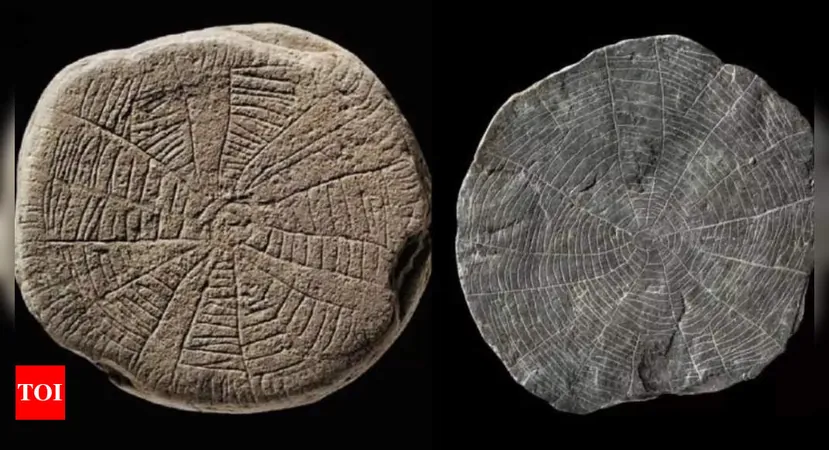
The Ancient Mystery of Sunstone Sacrifices: A Battle Against Climate Change
2025-01-17
Author: Arjun
In an astonishing revelation, researchers have uncovered that ancient inhabitants of Denmark's Bornholm island engaged in a ritualistic sacrifice of sunstones approximately 4,900 years ago. This unique practice, prompted by a cataclysmic volcanic eruption, was aimed at restoring sunlight that was vital for their agricultural survival.
The mystery surrounding these sunstones has captivated historians and archaeologists for years. But now, groundbreaking research published in the journal Antiquity has linked the stones' sacrificial offerings to environmental calamities believed to be caused by volcanic activity.
A Sunless World?
The volcanic eruption, which occurred around 2900 BCE, is thought to have significantly diminished sunlight, leading to fears of crop failures among ancient farmers. Rune Iversen, an archaeologist from the University of Copenhagen, stated, “For early agricultural civilizations, the Sun was everything. Without it, their way of life was threatened, and the idea of losing the Sun would have been terrifying.”
At the archaeological site known as Vasagård, over 600 sunstones have been uncovered, often intricately carved with designs symbolizing the Sun’s rays. These stones were not merely decorative; they were part of a larger spiritual framework that reflected the community's beliefs in the power of sunlight for fertility and growth.
The Ritual of Sacrifice
Evidence gathered from ice cores in Greenland shows a marked increase in sulfate levels coinciding with the time of the volcanic eruption. This suggests that the eruption released vast amounts of ash and gas into the atmosphere, leading to prolonged periods of low sunlight and severe climate conditions.
The excavation at Vasagård revealed that these sunstones, often palm-sized and radiating patterns, were purposely placed in ditches alongside remnants of ritual feasts, including animal bones and broken pottery. “The dedication involved in crafting these stones points to deep spiritual significance,” Iversen noted. “They were likely viewed as offerings to appease the Sun, possibly hoping to reverse the darkening skies.”
Cultural Shifts and Environmental Responses
Interestingly, in the aftermath of these sacrificial acts, a dramatic transformation occurred at the site. The layout shifted from open sacrificial ditches to fortified areas surrounded by palisades and circular structures, indicating significant changes in community structure and ritual practices. During this time, Europe was also experiencing significant upheaval due to migrations and perhaps wider climatic shifts.
Iversen posits that these changes reflect a society grappling with the implications of environmental disasters and the need for adaptation. “The climate had altered drastically, which may have prompted a reevaluation of their spiritual and cultural practices,” he added. “The transition from sunstone sacrifices to a more fortified site suggests the community's response to ongoing vulnerabilities.”
Conclusion: Spirituality in the Face of Disaster
The fascinating link between ancient rituals and climate events highlights the resilience and adaptability of human cultures in facing existential threats. The sacrifices made at Vasagård not only reveal the spirituality of the Neolithic peoples but also serve as a poignant reminder of the ongoing struggle between civilizations and the environment. As we face our modern climate challenges, the past offers both lessons and insights into the human capacity for hope and adaptation.
So, what can we learn from the ancients? Perhaps it’s time to reassess our relationship with nature and the ancient wisdom that could guide us in combating today's climate crises. Stay tuned for more riveting discoveries from our distant past!





 Brasil (PT)
Brasil (PT)
 Canada (EN)
Canada (EN)
 Chile (ES)
Chile (ES)
 Česko (CS)
Česko (CS)
 대한민국 (KO)
대한민국 (KO)
 España (ES)
España (ES)
 France (FR)
France (FR)
 Hong Kong (EN)
Hong Kong (EN)
 Italia (IT)
Italia (IT)
 日本 (JA)
日本 (JA)
 Magyarország (HU)
Magyarország (HU)
 Norge (NO)
Norge (NO)
 Polska (PL)
Polska (PL)
 Schweiz (DE)
Schweiz (DE)
 Singapore (EN)
Singapore (EN)
 Sverige (SV)
Sverige (SV)
 Suomi (FI)
Suomi (FI)
 Türkiye (TR)
Türkiye (TR)
 الإمارات العربية المتحدة (AR)
الإمارات العربية المتحدة (AR)